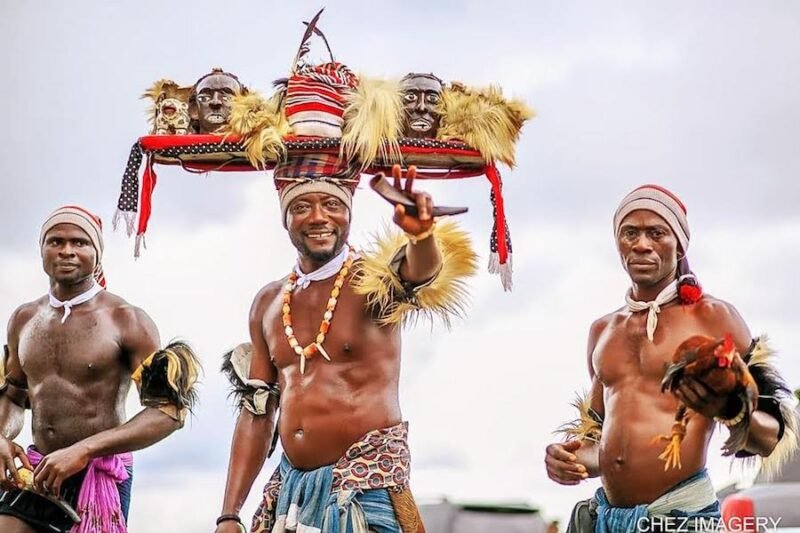By Amarachi Egbukichi- Ohafia
History: Ohafia is a town and local government area in Abia State, Nigeria. It is an igbo speaking region. The ancestral capital of Ohafia is located in the village of Elu. The Ohafia Local Government Area also includes the towns of Abiriba and Nkporo. Historically, Ohafia people left Andoli and settled in Isi-Eke, from where they ran away one night, when they heard the rattling sound of calabashes. The sound was interpreted to mean that they were being invaded which lead to a commotion, as some of them escaped toward Ngodo and others went towards Isuochi. At one point, some of them headed towards Abam leading the group heading to Abam, was a man known as Ezeama Atita, and Onyereobi Ezeama.

EZEMA ATITA AKPO, the founding father of OHAFIA had four sons, namely, in order of seniority: Amogu (Ama) Ezema Atita, Ukpai Ezema Atita, Otutu Ezema Atita, and Uduma Ezema Atita. Uduma Ezema Atita, the last of these sons, in turn, had 4 sons as his father and these are (again in order of seniority): Ezema Uduma Ezema, Chieze Uduma Ezema, Olori Uduma Ezema, and Uduma Uduma Ezema.
When they got to Abam, Onyereobi’s wife, who was heavy with pregnancy, could no longer walk. He, therefore, remained in Abam with his pregnant wife, while the group continued on the journey. In the present location of Ohafia, at a place called Ugwumgbo, Ezeama Atita, and his second son, Uduma, settled. After many years, their offspring established the 26 villages that makeup today’s Ohafia. The ancestral headquarters of Ohafia is in Elu Ohafia. Each village is governed by an eze ogo. All the eze ogo’s come together to form the Eze Ogo-in-Council, which, with the amala, decide how the community is to be governed. The overall traditional ruler, Udumeze, who lives in Elu Ohafia, intervenes only when there is a matter between an eze ogo and a subject.
THE HISTORY AND ORIGIN OF WAR DANCE
In the past, the culture of Ohafia was hinged around one’s prowess in war. They were constantly on the lookout for wars in which to take part. They became something like mercenaries and the people of Arochukwu, who were all over Igboland ‘hunting’ for slaves, harnessed this warlike spirit in Ohafia people to their own advantage. The ancestors of the Ohafia people were renowned as mighty warriors. This aspect in the History of Ohafia remains fundamental to the Ohafia people’s sense of identity.
The warrior’s cap or “leopard cap” (Igbo: Okpu agu) is well known and is an associated product of Ohafia. The Ohafia warrior tradition is embodied in the performance of iri agha The practise of beheading a fallen foe was a favourite pastime. A human skull was valued as a souvenir, and it was a proof of a man’s courage, which brought to the Ohafia man different types of honour. Only those who brought home a human head could join the Ogbu-Isi society and wear the eagle plume of courage. The love of military glory became a consuming passion and the focus of all social values.
The Ohafia people, whose warlike exploits made peaceful travel impossible, were now able to work abroad. By 1913, most of them were trading at Itu, in Akwa Ibom State, and Calabar, in Cross River State.
DOWNLOAD OHAFIA WAR DANCE SONG
THE EARLY LEGENDARIES OF OHAFIA AND THE INITIATION OF EDUCATION
Before now, the Ohafia man, with his entire war prowess, went through a ritual, to purge him of his war-like traits. Perhaps, he needed to be told by no less a force than the colonial might the old order had passed away. And it came about in 1901, when a unit of the Royal West African Frontier Force (RWAFF) based in Calabar laid a siege on Ohafia and Ebem. It was in response to the destruction of Obegu, in today’s Abia south, by fighters from the two communities. The Ohafia people had looked forward to that encounter. The people were in high spirit, sharpening their machetes and loading their dane guns with gun-powder. As usual, it was another opportunity for them to cut human heads. But, in their ignorance, they failed to realise that the firepower of the white man was far and above their crude weapons.
ENTER EKE KALU, the former slave. He had since returned from Opobo and was now visiting Calabar as a businessman, when preparations to raid Ohafia and Ebem were in high gear. The sight of RWAFF soldiers marching in Calabar, coupled with his experience in Eket when he was a gun carrier, compelled him to seek a way of saving his people. Eke Kalu knew from experience that his people, the famous and dreaded warriors of ancient Ohafia, the lions of the jungle, the proud and gallant sons of Uduma Ezema, would challenge the soldiers. He realised also that though the military tactics of the Ohafia warriors might surpass that of the RWAFF, yet their weapons were crude and nowhere near the firepower of the rifles and machine guns of the RWAFF soldiers. He, therefore, hurried out of Calabar in a canoe and, passing through Ikun, arrived Ohafia. It was an eke day and, on arrival, he went through the area, warning the people against challenging the soldiers.
Four days after his return, the British soldiers were on their way to Ohafia, taking the Akoli Adda route. Passing through Elu, they arrived in Ebem, where they pitched their tents at Ifi Iri-opu. Captain Mowatt commanded the soldiers.
No sooner did the soldiers arrive than an Ebem warrior, Idika Echeme, was said to have charged at them. Thereafter, the order to open fire was given on the other side of the line. Soon, trees and human beings began to fall. Each time cannon balls went off, trees and charging Ebem warriors were cut down. The pillar of Ikoro Nde Anaga also came down.
When they saw what was happening, the surviving Ebem warriors panicked and took to the forests for refuge. After Ebem was reduced to rubbles, the British soldiers turned their attention to Ohafia. As they approached, Eke Kalu wa waiting for them, not with machetes or dane guns. He had a long bamboo, at the top of which he tied a white handkerchief, which he waved frantically in the air, saying to the hearing of the approaching soldiers: “Ayi kwere na ndi beke”, meaning: “We surrender to the British”. Given his exceptional courage, Captain Mowatt was said to have demanded to know Eke Kalu’s identity. Coming close to the captain was an opportunity the former slave needed to demonstrate, before his people, his ability to speak English language. To the captain’s question, he proudly replied: “I from Elu Ohafia; my fadda, Imaga Agwunsi, say he no
wan war”. The captain was pleased.
LATE LEGENDARY EKE KALU’S HOUSE and to another question, he replied: “I is de onle man for Ohafia hear English”. When the British soldiers left Ohafia, the profile of the ex-slave rose among his people. The fact that he could engage a white man in a conversation earned him respect and honour. Consequently, they appointed him their adviser. The event that changed the course of Ohafia people forever occurred shortly after, and Eke Kalu was, again, at the centre of it. There was, in Ohafia, a Ohafia people”. The day came when he locked some men in the prison for what was described as a trivial offence. The men broke out of the prison and were intent on beating him up, when he reported the matter to one Major Cobham, who despatched some policemen to his rescue. The prisoners were promptly rearrested and fines were imposed on them.
After this event, Ohafia people started looking for a way out of what had become regular persecutions in the hands of the Sierra Leoneans. As the solution to their problem, Eke Kalu, advised them to build schools and educate their children who, knowing what the clerk knew, would better challenge him and his successors in the future. The first school was opened at Ndi Imaga Shed. From now on, the desire for education swept through Ohafia like a bush fire. Ohafia is home to the third-largest military base in Nigeria, named Goodluck Jonathan Barracks. It houses the headquarters of the newly established 14 Brigade and 145 Battalion office complex.
OHAFIA CULTURAL HOSPITALITY
The first thing an Akanu Ohafia man offers their visitors is Nzu (Kaolin), a native white chalk. This the visitor (if male) rubs on his hand, and (if female) rubs on either the neck or the tommy. This act is in no way fetish. It is done to prove that the visitor is welcome, and if accepted by the visitor proves the visitor has come in peace. After nzu has been given, the next thing offered is Kolanut. The oldest man in the house says prayers first before the kolanut is broken by the youngest male in the house. When sharing, the man of the house is served first, next is the visitor, then every other male from oldest to youngest before women. After the kolanut has been given, drink is brought (usually locally brewed gin), and it is shared in the same order the kolanut was shared. Everybody drinks from one cup!
26 OHAFIA VILLAGES AND THEIR FOUNDERS
1 Abia Onu Arunsi
2 Akanu Nna Uka
3 Amaekpu Ofali Agwu
4 Amangwu Uduma Nnagu
5 Amankwu Essien Aru
6 Amuke Ama Ezema
7 Amuma Uka Etim
8 Asaga Ukpai Ezema Atita [Okwara]
9 Ebem Kpoke + Mgbo Enine.
10 Elu Uduma Ezema
11 Ezi Afor Afo Okwara
12 Ihenta Eke Uma
13 Isi-ugwu Uduma Ali
14 Nde Anyaorie Anyaorie Uka
15 Nde Anku Iroha Ogwu
16 Nde Amogu Amogu Egbuta
17 Nde Ibe Ibe Okwara
18 Nde Okala Okala Iro
19 Nde Orieke Orieke Okwara
20 Nde Uduma Awoke Uduma Awoke Mbila
21 Nde Uduma Ukwu Uduma Ukwu
22 Nkwebi Ibe
23 Oboro Awa Okoro
24 Okagwe Dibia Ete
25 Okon Uma Elem
26 Ufiele Ukpai Uma

